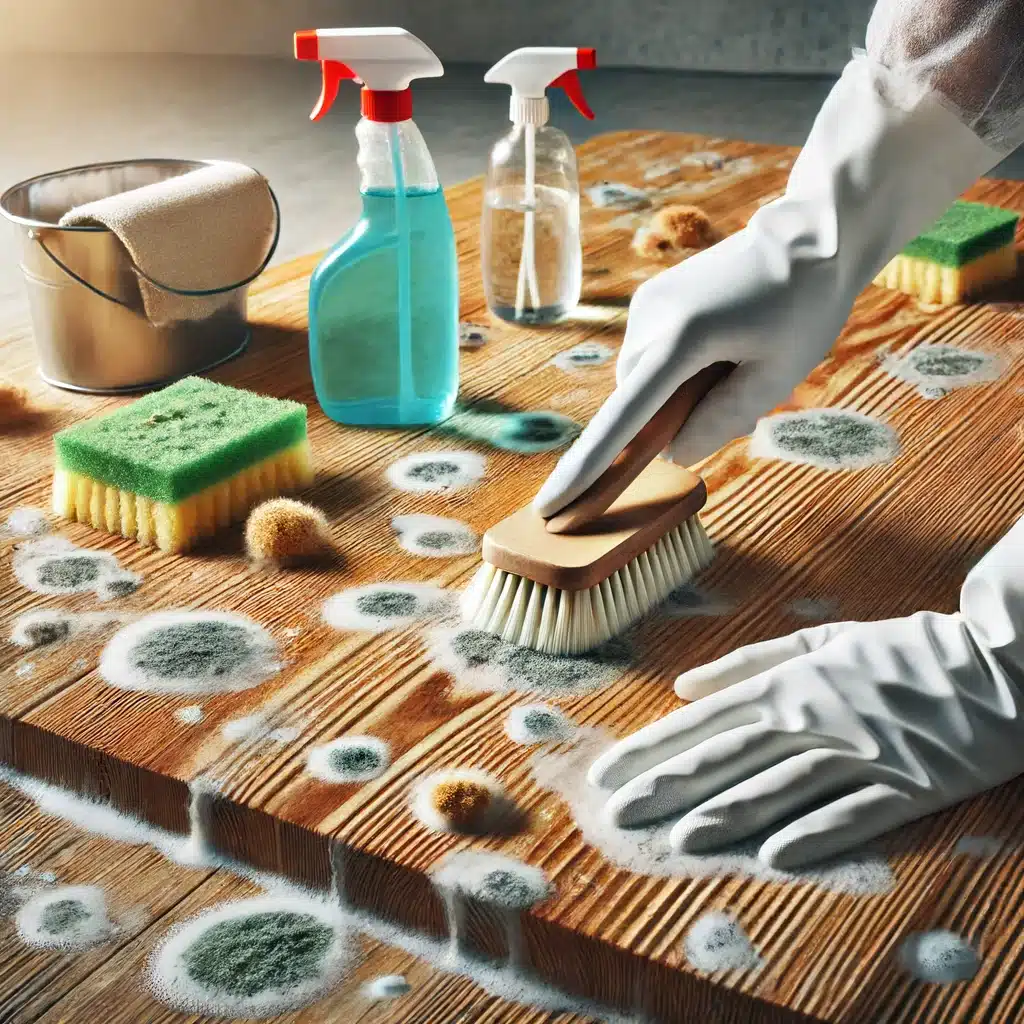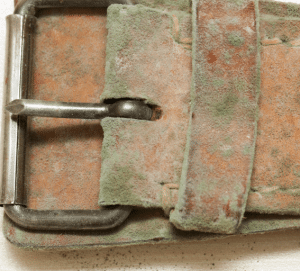Imagine discovering unsightly mold patches spreading across your beautiful wooden furniture or flooring. The horror, right? Addressing this issue swiftly and effectively is essential, not only to maintain the aesthetic appeal of your home but also to ensure a healthy living environment.
This blog will explore effective strategies for killing mold on wood. You’ll learn how to remove existing mold and how to prevent it from returning. Whether you’re dealing with mold on your favorite piece of furniture, key structural parts of your house, or decorative wooden elements, knowing how to handle mold is crucial. By the end of this guide, you’ll know how to restore and keep your wood surfaces clean and mold-free.
Understanding Mold on Wood
What is Mold?
Mold is a type of fungus that can grow on various surfaces, including wood. It reproduces through tiny spores that travel through the air and thrive particularly well in moist environments. When these spores land on a damp spot on wood, they can start to grow and spread, often leading to visible and damaging colonies.
Causes of Mold Growth on Wood:
Several conditions can promote mold growth on wood, with the primary factor being moisture. Whether it’s from high humidity, water leaks, or condensation, wood that remains damp can become a breeding ground for mold. Poor ventilation exacerbates the issue by trapping moist air and creating an ideal environment for mold to thrive. Other contributing factors include lack of sunlight and warm temperatures, which can accelerate mold growth.
Health Risks of Mold:
Mold on wood isn’t just a structural or aesthetic issue—it can also pose serious health risks. Exposure to mold can cause a variety of symptoms, especially in those with mold allergies or compromised immune systems. Common reactions include respiratory issues like coughing, wheezing, and shortness of breath, as well as nasal stuffiness, eye irritation, or skin rashes. In more severe cases, mold exposure can lead to more serious allergic reactions.
Identifying Mold on Wood
- Visual Signs:
Recognizing mold on wood starts with a keen eye for visual cues. Mold typically appears as discolored patches which can vary in hue from white and gray to black, green, or even yellow. The texture of mold can also help in identification—it may look fuzzy, especially if it’s in the early stages of growth, or it can appear slimy when there’s excessive moisture. When inspecting wood for mold, pay close attention to areas that are prone to dampness or have poor air circulation.
- Smell Test:
Mold has a distinctive musty odor, reminiscent of wet socks or rotten wood, which can often lead you to its presence even before it’s visibly detectable. If a section of your woodwork or furniture smells musty, it’s prudent to inspect it more closely for other signs of mold, especially if the area has been exposed to moisture.
- Hidden Mold:
Detecting mold hidden beneath surfaces or behind walls can be challenging but is crucial for thorough mold management. Some tips for uncovering hidden mold include:
- Inspect for Water Damage: Look for water stains or discoloration on wood surfaces, which often indicate a moisture problem that could also mean hidden mold.
- Check Behind Furniture and Fixtures: Mold can grow out of sight, such as behind cabinets, under sinks, or behind wallpaper and paneling. Move furniture away from walls and check in these concealed areas regularly.
- Use Moisture Meters: These devices can help detect moisture levels in wood without the need for invasive measures, pinpointing areas that might foster mold growth.
- Professional Assessment: If you suspect a hidden mold and can’t find it yourself, consider hiring a professional. They have specialized tools, like infrared cameras, that can detect mold behind surfaces without the need for demolition.
By being diligent in identifying mold on wood, you can take swift actions towards killing mold on wood effectively, thereby safeguarding your home and health.
Preparing to Kill Mold on Wood
Safety Precautions:
Before you begin the process of killing mold on wood, it’s essential to prioritize your safety. Mold can release spores that are harmful to breathe in, especially during the cleaning process. Protect yourself by wearing the right gear: rubber gloves to protect your hands, N-95 masks to prevent inhalation of mold spores, and goggles to shield your eyes. Ensuring you have these items on can make the cleaning process safer and more effective.
Ventilation:
Proper ventilation is crucial when you’re working to remove mold. It helps disperse any airborne spores that get disturbed during the cleaning process, reducing your exposure. Before you start, open windows and doors to allow fresh air to circulate through the area. If possible, use fans to help drive the air outwards and keep the space well-ventilated throughout the entire process.
Gathering Supplies:
Having the right cleaning supplies on hand is key to effectively killing mold on wood. Here’s a list of recommended supplies:
- Vinegar: A safe and natural option, vinegar can kill most types of mold on wood surfaces.
- Baking Soda: Useful for scrubbing away mold while being gentle on wood, baking soda also helps deodorize the area.
- Commercial Mold Cleaners: These are specially formulated to tackle mold on various surfaces, including wood. Choose a cleaner suited for wood to avoid any damage.
- Scrub Brush: A stiff-bristled brush will help you thoroughly remove mold from the wood surface.
Prepare these supplies ahead of time to streamline your mold removal process. With the right preparations in place, you can effectively tackle the task of killing mold on wood, ensuring your home is not only clean but also healthy.
Methods for Killing Mold on Wood
Natural Solutions:
One of the most effective natural ways to address mold on wood is using vinegar and baking day. Here’s how to use these ingredients:
- Vinegar: Vinegar is a mild acid that kills most mold species. Simply fill a spray bottle with white distilled vinegar and spray it generously on the moldy wood. Allow it to sit for at least an hour to penetrate and kill the mold spores before wiping the area clean with water.
- Baking Soda: After treating the wood with vinegar, you can use baking soda to further clean and deodorize the area. Mix a quarter tablespoon of baking soda with water in a spray bottle, shake until the baking soda dissolves, spray it on the treated area, and then scrub with a brush. Finally, rinse with water and dry thoroughly.
Commercial Cleaners:
Commercial mold removers can be a robust option for those who prefer ready-made solutions. Products containing bleach can kill mold on non-porous surfaces, but for wood, look for removers specifically formulated to treat porous materials without causing damage. Always follow the manufacturer’s instructions for the best results.
Step-by-Step Cleaning Process:
Here’s a detailed guide to effectively remove mold from wood:
- Prepare the Area: Ensure the room is well-ventilated. Wear protective gear such as gloves, goggles, and a mask.
- Apply the Cleaning Solution: Whether you’re using vinegar or a commercial mold remover, apply it liberally to the affected areas. If using vinegar, let it sit for one hour; for commercial cleaners, follow the time recommended on the label.
- Scrub the Mold: Using a stiff-bristled brush, scrub the mold off the wood. Be thorough but gentle to avoid damaging the wood surface.
- Wipe Clean: After scrubbing, wipe the area with a damp cloth to remove any mold residue and cleaner.
- Dry the Wood: It’s crucial to let the wood dry completely to prevent mold from returning. Use fans or dehumidifiers to speed up the drying process.
By following these steps for killing mold on wood, you can restore the appearance and integrity of your wooden surfaces and maintain a healthier home environment.
Preventing Mold Growth on Wood
Control Humidity:
Maintaining low humidity levels is crucial in preventing mold growth on wood. Aim to keep indoor humidity below 60%, as higher levels can provide the moisture that mold spores need to grow. You can achieve this by using air conditioners during humid months and running dehumidifiers in particularly damp areas of your home, such as basements or bathrooms. Additionally, simple habits like drying wet surfaces and fixing any leaks promptly will help keep the humidity levels in check.
Improve Ventilation:
Proper airflow is essential in preventing mold on wood by ensuring that moisture does not get trapped in any part of your home. Make sure all rooms are well-ventilated, especially areas like kitchens and bathrooms where moisture is generated frequently. Utilize exhaust fans and open windows when possible to improve air circulation. If natural ventilation is insufficient, consider using dehumidifiers to help reduce the moisture content in the air.
Regular Inspections:
Conducting routine inspections of your home can prevent mold growth by identifying and resolving moisture issues before they lead to mold. Regularly check for signs of leaks and water damage, particularly around roofs, pipes, windows, and in the basement. Pay special attention to wooden structures such as beams, cabinets, and flooring. Fixing these problems quickly not only prevents mold but also protects the structural integrity of your wood and your home.
Implementing these strategies for controlling humidity, improving ventilation, and conducting regular inspections can effectively prevent mold from taking hold on your wooden surfaces. This proactive approach is key to maintaining a mold-free environment and protecting your home from potential damages caused by mold growth on wood.
FAQs on Killing Mold on Wood
How do I know if mold on wood is harmful?
Not all molds are toxic, but many can cause allergic reactions and respiratory issues. If you see mold growing on wood, it’s best to treat it as potentially harmful, especially if you or someone in your home is sensitive to allergens.
Can I paint over mold to kill it?
No, painting over mold is not an effective solution. This approach can actually seal in the spores beneath the paint layer, potentially worsening the problem as the mold continues to grow underneath. It is essential to completely remove the mold before painting any surface.
Is bleach effective in killing mold on wood?
Bleach is not recommended for killing mold on wood. While it might remove the mold’s appearance on the surface, bleach does not penetrate wood deeply enough to kill the root structure of the mold. Additionally, it can weaken and damage wood fibers, compromising the structural integrity of the wood.
Can mold on wood cause health problems?
Yes, exposure to mold on wood can lead to a range of health problems. While the severity can vary, common issues include allergic reactions, such as sneezing, itching, and respiratory distress. For people with asthma or compromised immune systems, the presence of mold can lead to more severe health complications.
How often should I try the of for him on what affected I you’re regularly after checking period stood surfaces?
It’s wise to check for mold on wood surfaces regularly, particularly after instances of water damage, during prolonged periods of humidity, or in naturally damp environments like basements and bathrooms. Regular inspections can help catch mold growth early, making the process of killing mold on wood much easier and preventing potential health risks and structural damage.
Conclusion
The importance of killing mold on whole wood cannot be overstated, given its potential to damage your home and impact your health. We discussed various effective methods, including using natural solutions like vinegar and baking soda and appropriate commercial cleaners. Remember, the key steps involve identifying the mold, safely removing it, and taking measures to prevent future growth.
If you discover mold in your home, it’s crucial to act immediately to address the issue before it spreads or causes further damage. Regular maintenance, such as controlling humidity levels, improving ventilation, and performing routine inspections, can help keep your home mold-free.
For professional assistance, consider reaching out to Mold Testing Houston. They offer comprehensive mold inspection and testing services, ensuring that your living space remains safe and healthy. Don’t hesitate to seek professional help to manage mold problems in your home effectively.
End Note
Experience the confidence of a mold-free home with Mold Testing Houston, your expert in eliminating mold-related health risks. Our services are essential whether you’re in the dynamic city center of Houston or the quiet neighborhoods of The Woodlands. We specialize in a comprehensive range of mold testing services designed to uncover even hidden mold infestations, particularly mold on wood.
We take great pride in delivering exceptional service at Mold Testing Houston, ensuring the well-being and safety of our clients. Our passionate professionals are dedicated to maintaining a healthy and secure environment in your living spaces.
Explore our mission and meet the dedicated team behind our success by visiting our About Us page. For further insights into the importance of mold testing and tips for keeping your home mold-free, check out our blog. Follow us on Facebook for the latest updates and expert advice from our team.
Don’t let mold put your health at risk. Head over to our Contact page to schedule a mold testing appointment today. Join the community of satisfied customers who rely on Mold Testing Houston to keep their homes safe and clean. At Mold Teaching Houston, your health and safety are always our top priorities.





